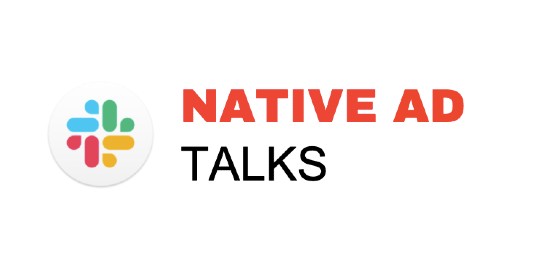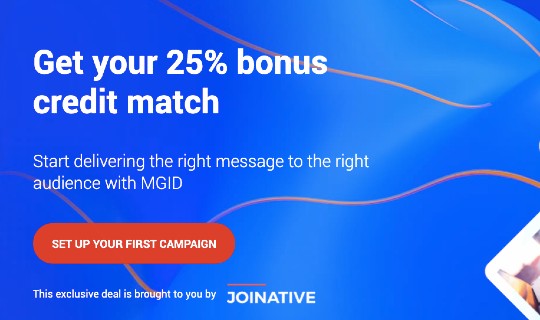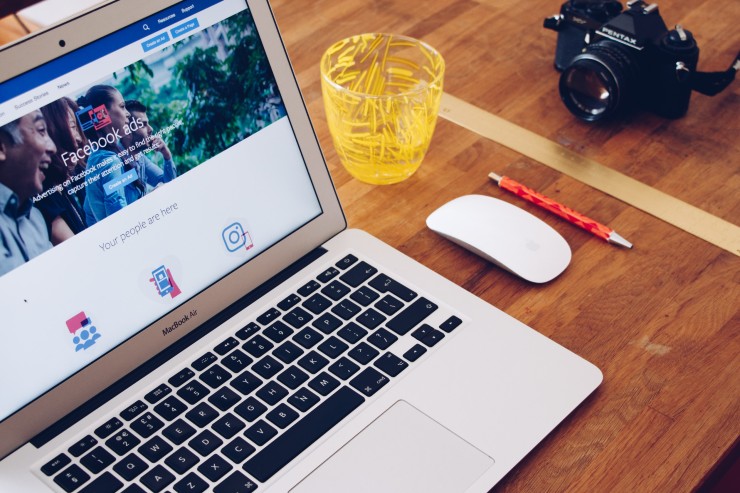
Why & How to Repurpose Your Facebook Ads for Native
How do you start with native advertising when you have experience with Facebook ads? Copying your Facebook ads campaigns and launching them on native ad platforms won’t work. There are quite a few aspects that you need to consider, including targeting options, creatives, tracking setup, etc.
These days many advertisers, including our agency clients, are reducing their Facebook ad budgets to diversify their advertising strategies or focus on channels that give them more space to scale than any other social platform does. Among other Facebook ads alternatives, a lot of attention is given to such advertising platforms as Taboola, Outbrain, MGID, and others.
We talked to Katarina Ereš, Director Mid Market & Publisher Sales at Outbrain and learned her opinion on this growing trend of shifting from social channels to native discovery:
‘Regarding other marketers switching from Facebook, we saw some positive signs and many companies being curious about other channels - and a little surprised what we offer because they never really looked into alternatives to the few platforms actively. Ultimately, we hope this trend will lead to less dependency from just a few platforms and a healthier marketing landscape.’
Ads served by native ad platforms match the look and feel of the editorial content, just like Facebook ads do. So if there’s the same idea behind these advertising approaches, why won’t they work similarly with the same assets, creatives, and campaign settings?
Read on to discover how these two differ and learn how to repurpose your Facebook campaigns for native ad platforms.
Facebook ads vs Native ads
How do Facebook ads differ from native ads?
Here we can’t help but agree with the words of David Morneau, CEO at inBeat agency:
When used correctly, they work better than Facebook advertising. The key to success with native ads is to create content that is relevant and educational.
As a result of their focus on customer experience and quality content, they are a solution to adblocking. By being more personalized and relevant to the context, they reach the most relevant audience and have higher credibility than other types of ads.
In our experience, native ads generate 60% more engagement than Facebook Ads because they are user-friendly and not annoying. They blend with the content that users are viewing and let you through the consumer’s defenses.
And now, let’s go into detail.
Format
While you aren’t limited in the number of words you can use in your in-feed Facebook ads, a typical native ad contains a 30-70-character headline with no space for additional texts.
As organic snippets in the publisher environment typically include an image and a short title, native ads would fail to look ‘native’ if they included longer descriptions.
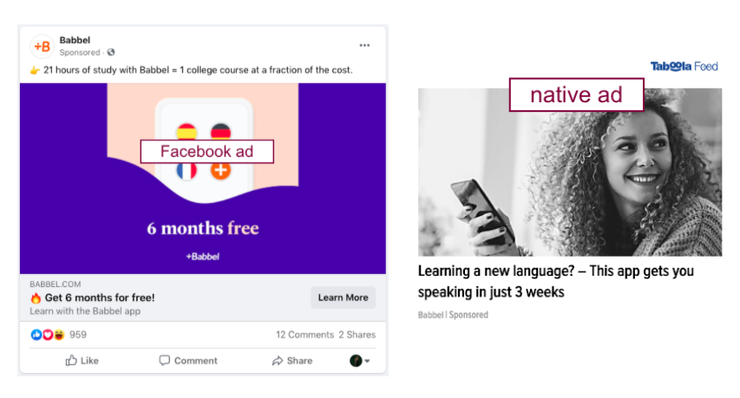
Costs
It’s no secret that Facebook ads aren’t the cheapest advertising option. The average CPC on Facebook across all industries is about $1.72.
Native ads are more affordable. The average CPC ranges from $0.20 to $1.00 depending on the native ad platform, device type, targeting options, and other factors.
Algorithms
Native advertising is so beloved by affiliate marketers as it’s not so algorithm-dependent. While advertisers need to take efforts to deal with account bans and ad rejections, native ad platforms often have more reasonable guidelines and policies.
Reach
Millions of people worldwide are Facebook users. Millions of people worldwide read news websites and online magazines. In most cases, these are the same people. But the way you reach them on these channels will differ.
Facebook ads are known for advanced targeting options that advertisers can access. Therefore, it’s common to target specific audiences based on their interests, demographics, connections, and/or behavior. By applying multiple filters, you narrow down your reach and target only audiences that are most likely to convert.
Native ads are way more effective when you apply a broader, location and/or device-based targeting. You’d better craft your ads so that they attract only relevant people, instead of relying on algorithms and limiting your opportunities.
Results
We must admit that Facebook delivers results faster than native ad platforms.
In his interview for Outbrain, James Van Elsywk shares his experience of switching from Facebook to native ad platforms: ‘Native takes a little more time, though leads to increased, stabilized profitability.’
It takes time to build effective native advertising campaigns. When you allocate a budget on Facebook ads, your money is spent on one platform only. But when you run native ads, your budget is distributed across thousands of websites your ads are served on.
To see which native ad placements perform well and which don’t, you need to obtain enough data. And after you’ve conducted performance analysis, blacklisted worst-performing sites, and boosted your CPCs for the most effective placements, you’ll start seeing great results that will last long.
How to repurpose Facebook ads for native
Facebook and native ad platforms are completely different channels with a few similar features. But these features make replicating your Facebook campaigns on native a lot easier.
‘Usually, when people are on Facebook, they browse information shared by friends, from news and entertainment websites and sponsored content from brands,’ says Jitesh Keswani, CEO at e-intelligence. ‘The sponsored content on Facebook is useful, but with time can deteriorate in performance.
Native advertising has a solution to this problem. Native advertising shows up on many news sites, blogs, and apps that the Facebook audience is already familiar with, and it’s easy to adapt an already existing Facebook campaign to native advertising.’
In the further sections, you’ll learn how to select Facebook campaigns, adjust them, and build high-performing native advertising campaigns.
Pick a campaign
Once you decide to shift some part of your budget or switch completely on native, you’ll want to find ways to make the most out of your experience with Facebook ads. You already have quite a few assets that might be useful for your future campaigns, so why reinvent the wheel?
When selecting one or a few campaigns to repurpose for native, make sure you pick the ones with the highest potential. It’s important that you consider the campaign performance data, but it’s not enough. Chances are your high-performing Facebook campaigns – and here we mostly talk about your landing pages – won’t be equally effective when repurposed.
Here are the types of landing pages that audiences of media outlets might want to interact with:
- Quizzes
- Product comparisons
- Independent reviews
- Stories
- Special offers
- News articles and blog posts
Defined the most successful Facebook campaigns? Now, review landing pages used there. Is there any content that has a higher potential for getting noticed and being interacted with? You know what to do.
If you still want to use product pages as campaign assets, we recommend that you add presell pages – content users see before an actual offer is introduced. These pages can contain any of the content formats we’ve listed above.
On-Demand Video Course On Native Advertising
Boost your ROAS with native ads. Enroll now with our limited 30% discount.
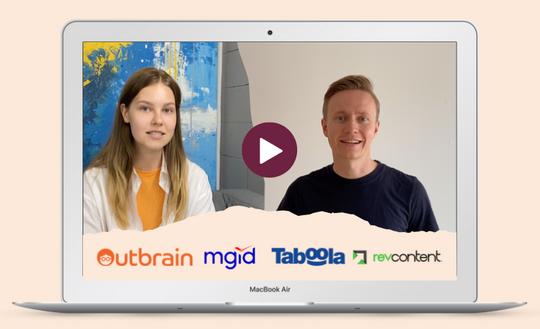
Adjust the campaign setup
Before you launch, you’ll need to go through the campaign setup process as if you’ve never been running these campaigns before. Although some settings might work similarly on Facebook and native, you’ll still need to make quite a few adjustments when transitioning your campaigns to a new platform.
Targeting
As has been said, native works better with broader targeting settings. And here’s where the experience you got when running your Facebook campaigns will come in handy – by reviewing the performance reports, you’ll get insights into how this or another landing page performs for the specific locations and devices.
When defining targeting options on a native ad platform, follow these tips:
- Switch to location and device-based targeting. The broader you start the more insights you’ll get.
- Split your campaigns by device – it’s not only a cheaper but also a more effective way to optimize your campaigns for different user behavior.
- Track early signals that might help you better understand how your campaigns are performing. Before you have enough historical data on CTRs and conversion rates, check Google Analytics for user behavior metrics, such as time on page, bounce rates, and scroll depth. Exclude placements with suspicious activity.
- After 1-2 days of your campaigns being live, you can start excluding placements that don’t perform well for the specific ad (on ad-level) or campaign (on campaign-level).
Retargeting is also available on native ad platforms. If you’ve been running successful retargeting campaigns on Facebook, you can go on and target the same audiences with your native ad campaigns.
To make the most of your Facebook campaigns, you might also want to retarget your campaign clickers with native ads. You can simply retarget people who have visited your landing pages or capture specific Facebook events with Google Tag Manager and define them as triggers for the Taboola retargeting pixel.
Bidding
Like Facebook, top-notch native ad platforms can optimize your bids towards the best results if you enable the automated bidding feature.
With automated bidding, you set the baseline bid amount, and the platform will automatically adjust it to make your ads win more impressions that are more likely to capture conversions.
It’s usually recommended that you start with higher than the average bids and apply automated bidding tools to ensure your ads are served on the top publishers’ websites from the very beginning. As you progress, you can start lowering your bids day after day on the ad, site, or campaign-level.
Adapt creatives
You’ve already seen the difference between Facebook and native advertising creatives.
‘Consider that Native Discovery is still a unique channel, so you might need to invest some effort, time and budget to scale your campaigns,’ says Outbrain’s Katarina Ereš. ‘It might be just a word in the headline that might make a huge difference on our platform, so plan for some A/B testing and go for the long run. It will definitely be worth it.’
Now, let’s see what you can do to shorten headlines and adjust your images without the loss of meaning.
Titles
In native advertising, your title will be the only place where you can describe your offer and competitive advantages – all in 30-80 characters. How do you make your Facebook creatives fit these requirements?
Here are a few tips for you:
- Identify your top Facebook ad copies and try to convey similar messages in your native ads.
- Focus on the benefits your customers will get if they buy from you.
- Mention facts, numbers, or prices if possible.
- Be precise. Your native ad copy is your chance to filter out irrelevant audiences.
- Appeal to their curiosity. Is there anything special that might entice users to click? Catch their attention, but remember that you don’t want to set false expectations.
Thumbnails
If you want to use your Facebook images in your native ad campaigns, think twice. All those well-crafted designs with texts or infographics might be way less effective on native than regular images. With this in mind, we recommend that you follow these practices when selecting or creating thumbnails for your future native ad campaigns:
- Use non-polished but quality imagery. Graphic imagery is rarely perceived well by audiences of news websites.
- Avoid stock photos that are not related to your offer.
- Make sure the subject in your image is centered. Images might be cut differently to fit placements.
- Check Taboola trends for more insights into what image characteristics perform best across different categories.
Tracking
When you start with a run-of-network approach (the opposite of hyper-targeting), your campaign success will be determined by how well you can interpret the performance data and optimize your campaigns based on these insights. To ensure you get reliable reports, it’s crucial to set up a custom reporting and analytics solution.
To track conversion events with Google Analytics or your custom BI solution, you need to create proper UTM parameters that can be easily decoded. Here are a few examples of the UTMs used by the Joinative team on Outbrain and Taboola:
https://yourdomain.com/landingpage?utm_source=outbrain&utm_medium=discovery&utm_campaign=campaign_name&utm_content=&utm_term=_– Outbrainhttps://yourdomain.com/landingpage?utm_source=taboola&utm_medium=discovery&utm_campaign={campaign_id}&utm_content={campaign_item_id}&utm_term={site_id}– Taboola
Want to spend less time setting up and exporting reports? Looking for a solution that will enable you to build custom performance reports for Taboola and Outbrain in seconds? Native Pro makes native advertising reporting and optimization easier. Book a demo and discover how you can build more informative performance dashboards with Native Pro.
Need help?
To help you make the most of native advertising, we offer 3 different packages:
- Native Starter. If you need a native advertising consultancy, this package is right for you – our experts will guide you through the processes of campaign creation, performance tracking, testing, and optimization so that you can run effective campaigns by yourself when the training is over.
- Native Managed. Looking for someone to run native ad campaigns for you? Our experts will take care of your campaigns and ensure your goals are met.
- Native Audit. What if you’ve already launched your first native ad campaigns and the results don’t meet your expectations? After reviewing your campaigns thoroughly, we’ll identify performance issues and suggest workable solutions that will maximize your native advertising ROI.

 Feed
Feed
